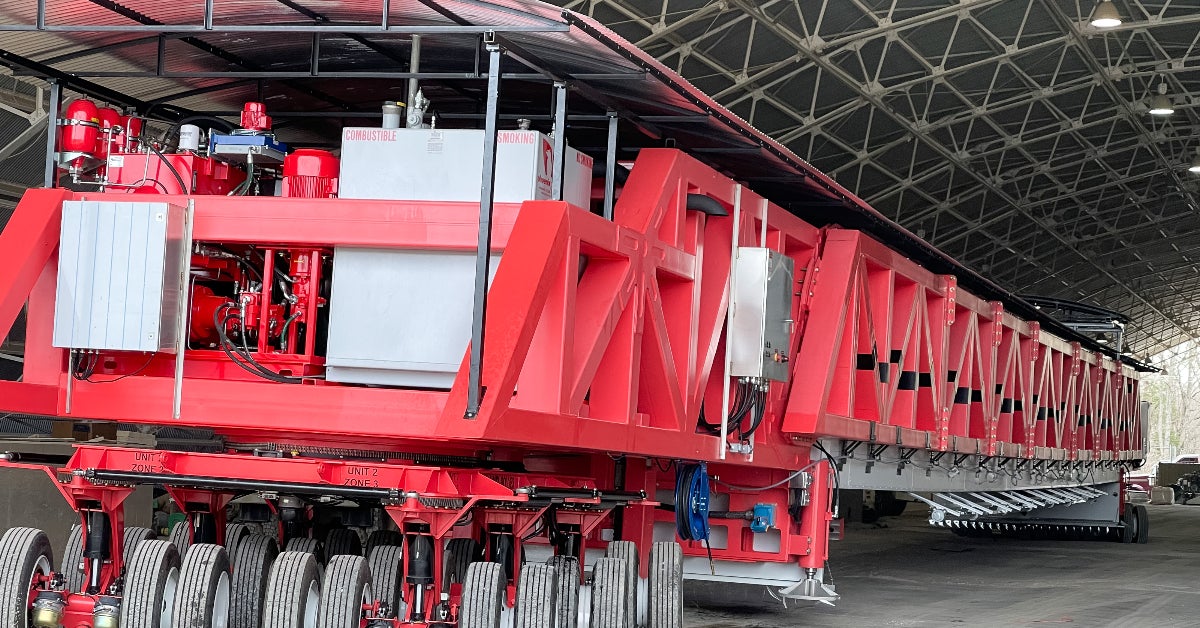ERDC begins testing with world’s largest heavy vehicle simulator
Published 4:26 pm Tuesday, March 15, 2022

- The U.S. Army Engineer Research and Development Center’s newly assembled HVS Titan has the unique ability to apply a dynamic impact load to simulate the load induced at aircraft touchdown. No other heavy vehicle simulator includes this full-scale vertical impact loading capability. The Titan is a critical research tool used to evaluate new materials, design methods and construction techniques that can help optimize new infrastructure facilities. (U.S. Army Corps of Engineers photo)
The U.S. Army Engineer Research and Development Center (ERDC) completed assembly on the world’s largest heavy vehicle simulator (HVS), the “Titan,” at the end of January. The HVS is a critical research tool used to evaluate new materials, design methods and construction techniques that can help optimize new infrastructure facilities.
“We are excited to receive the HVS Titan from our industry partner, Dynatest,” said Jeb Tingle, senior scientific technical manager from ERDC’s Geotechnical and Structures Laboratory. “This new accelerated pavement testing capability will keep ERDC at the forefront of transportation infrastructure research for the foreseeable future and equip the ERDC with the required tools to provide effective sustainable infrastructure to the Army, the Department of Defense and the Nation.”
“The Titan is the world’s largest HVS and has the unique capacity to simulate ground vehicles, aircraft and rail traffic up to 120,000 pounds,” said ERDC Director Dr. David Pittman, who also serves as chief scientist and director of research and development for the U.S. Army Corps of Engineers. “It was developed in partnership with Dynatest. This new capability expands ERDC’s ability to support a wide range of unique military vehicles to help develop better transportation infrastructure solutions.”
The U.S. Department of Defense (DOD) mission is critically reliant upon its transportation infrastructure, including road networks, bridges, airfields and railroads. The DOD manages billions of dollars in transportation infrastructure assets and invests millions of dollars each year in the design, construction, evaluation and maintenance of its transportation infrastructure to ensure that its transportation network is capable of supporting critical mission requirements.
Like the aging civilian infrastructure networks, the DOD’s vast infrastructure investment is aging, creating significant budgetary demands in a budget-constrained environment. Compounding the issue is the evolving and complex configurations of new military and commercial vehicles and aircraft that require innovative transportation facilities to ensure safe operating conditions.
In order to meet the demands of maintaining an aging infrastructure and developing new design requirements for modern military vehicles, DOD and civilian engineers must take advantage of new materials and methods for infrastructure design and construction that allows them to maximize the impact of limited funding. Thus, advancements in materials, design methods and construction technology offer opportunities to improve the condition of the current infrastructure while optimizing the investment in new infrastructure.
Prior to acquiring the new HVS Titan, the ERDC possessed two aging HVS systems, a small unit HVS designed only for ground vehicle loading and a larger HVS-A designed to simulate ground vehicles, aircraft and rail traffic.
ERDC researchers saw the need to replace the larger HVS-A system to enhance and modernize the DOD’s ability to perform meaningful infrastructure research on roads, bridges, airfields and railroads.
“The new HVS Titan includes a total travel span of 75 feet and is capable of applying over 18,000 simulated vehicle passes per day, providing the ability to perform multiple pavement tests simultaneously and maximizing testing efficiency,” Tingle said. “The HVS Titan also includes a unique ability to apply a dynamic impact load to simulate the load induced at aircraft touchdown. No other heavy vehicle simulator in the world includes this full-scale vertical impact loading capability.”
The HVS Titan is equipped with a powerful climatic control unit capable of maintaining a constant programmable test temperature selected from 20 degrees to 110 degrees. The ability to control test temperature for a wide range of operational conditions ensures the ability to conduct meaningful testing under relevant environmental conditions.
“I am proud that this work is taking place in the 2nd Congressional District,” said U.S. Congressman Bennie G. Thompson. “I look forward to seeing how this critical research will assist in the modernization of infrastructure efforts and create transportation solutions across the state of Mississippi.”
“ERDC’s expanded capability to test and prove better transportation infrastructure techniques will benefit not only our national security, but also states and cities as they ramp up upgrades to highways, bridges, and airports,” U.S. Senator Cindy Hyde-Smith said. “I have every confidence in the Army Corps researchers in Mississippi who will put this new heavy-duty simulator to work.”





